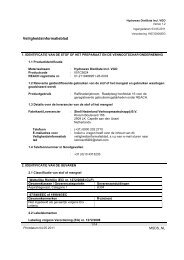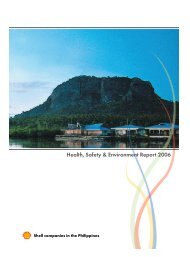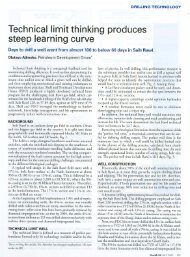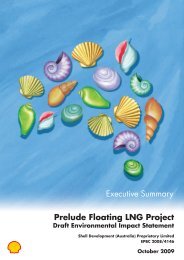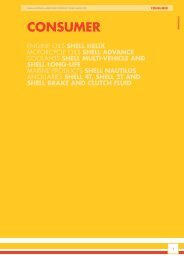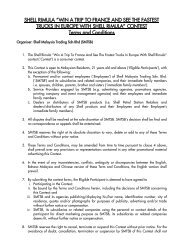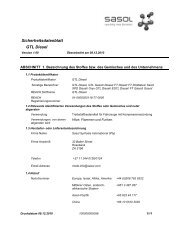Safety Data Sheet - Shell
Safety Data Sheet - Shell
Safety Data Sheet - Shell
You also want an ePaper? Increase the reach of your titles
YUMPU automatically turns print PDFs into web optimized ePapers that Google loves.
<strong>Safety</strong> <strong>Data</strong> <strong>Sheet</strong><br />
<strong>Shell</strong> GTL Distillate<br />
Version 1.5<br />
Effective Date 03.11.2011<br />
appropriate positive pressure breathing apparatus. Where airfiltering<br />
respirators are suitable, select an appropriate<br />
combination of mask and filter. All respiratory protection<br />
equipment and use must be in accordance with local<br />
regulations.<br />
Hand Protection : Personal hygiene is a key element of effective hand care.<br />
Gloves must only be worn on clean hands. After using gloves,<br />
hands should be washed and dried thoroughly. Application of a<br />
non-perfumed moisturizer is recommended. Suitability and<br />
durability of a glove is dependent on usage, e.g. frequency and<br />
duration of contact, chemical resistance of glove material,<br />
glove thickness, dexterity. Always seek advice from glove<br />
suppliers. Contaminated gloves should be replaced. Select<br />
gloves tested to a relevant standard (e.g. Europe EN374, US<br />
F739). When prolonged or frequent repeated contact occurs,<br />
Nitrile gloves may be suitable. (Breakthrough time of > 240<br />
minutes.) For incidental contact/splash protection Neoprene,<br />
PVC gloves may be suitable.<br />
Eye Protection : Chemical splash goggles (chemical monogoggles).<br />
Protective Clothing : Chemical resistant gloves/gauntlets, boots, and apron (where<br />
risk of splashing).<br />
Thermal Hazards : Not applicable.<br />
Monitoring Methods : Monitoring of the concentration of substances in the breathing<br />
zone of workers or in the general workplace may be required to<br />
confirm compliance with an OEL and adequacy of exposure<br />
controls. For some substances biological monitoring may also<br />
Environmental Exposure<br />
Controls<br />
be appropriate.<br />
9. PHYSICAL AND CHEMICAL PROPERTIES<br />
: Local guidelines on emission limits for volatile substances must<br />
be observed for the discharge of exhaust air containing vapour.<br />
Appearance : Colourless. Liquid.<br />
Odour : <strong>Data</strong> not available<br />
Odour threshold : <strong>Data</strong> not available<br />
pH : <strong>Data</strong> not available<br />
Initial Boiling Point and<br />
Boiling Range<br />
: 160 - 360 °C / 320 - 680 °F<br />
:<br />
Flash point : > 75 °C / 167 °F<br />
Upper / lower<br />
Flammability or<br />
Explosion limits<br />
: 0.5 - 5.0 %(V)<br />
Auto-ignition temperature : > 215 °C / 419 °F<br />
Vapour pressure : < 0.1 kPa at 25 °C / 77 °F<br />
Relative Density : 0.77<br />
Density : Typical 0.77 g/cm3 at 15 °C / 59 °F<br />
Water solubility : Negligible.<br />
Solubility in other<br />
solvents<br />
: <strong>Data</strong> not available<br />
n-octanol/water partition<br />
coefficient (log Pow)<br />
: > 6.5<br />
Dynamic viscosity : <strong>Data</strong> not available<br />
7/11<br />
Print Date 03.11.2011 000000021991<br />
MSDS_IMO




